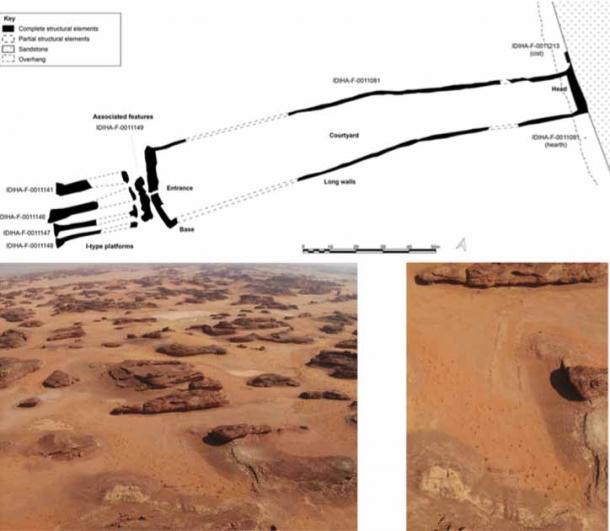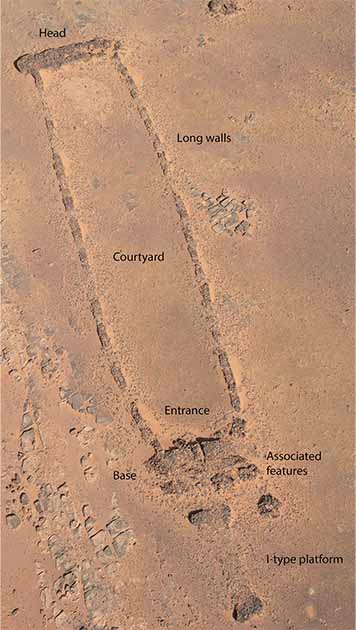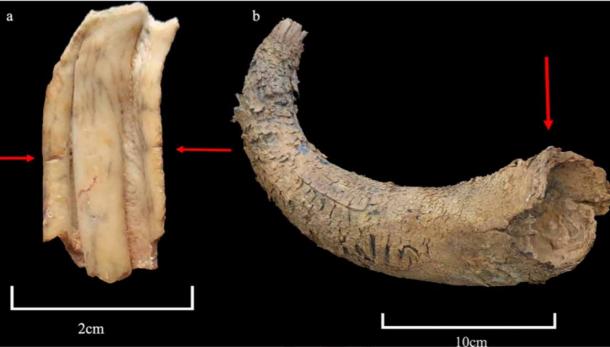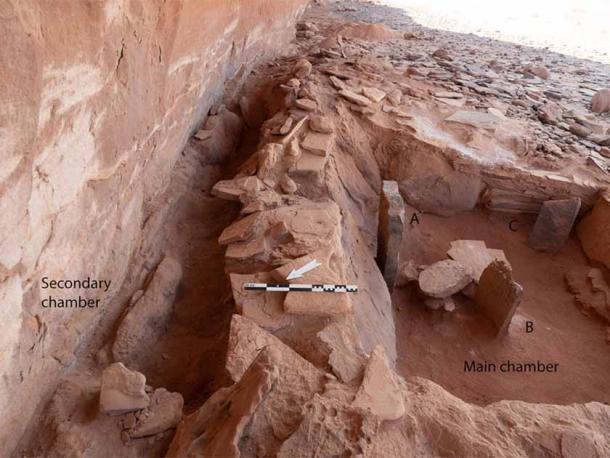The Cult, Pilgrimage – and Herding Past of a Saudi Arabian Mustatil
Within the desolate landscape of Saudi Arabia lie massive rectangular structures known as the mustatil. Dating back to the Late Neolithic era, researchers believe they were once used for ritualistic purposes. A team of archaeologists have now published the results of in-depth excavations of one of these enormous constructions located near AlUla, revealing hereto unknown evidence of ceremonial customs in Saudi Arabia thousands of years ago.

Plan of the Saudi Arabian mustatil site near Alula excavated for the study. (Kennedy et al. - PLOS ONE / CC-BY 4.0)
Rectangles of the Gods: Decoding the Saudi Arabian Mustatil
The word mustatil is Arabic for “rectangle” and these large, rectangular, stone-built structures are found in the northwestern region of Saudi Arabia, known as AlUla. Dating to around 7,000 years ago, the first mustatils were only discovered in 2017. To date, more than 1,600 Saudi Arabian mustatils have been discovered.
Comprising rectangular walls, which are most often aligned in a north-south and east-west orientation, these stone structures are most often enclosed by larger outer walls. The effect is that the Saudi Arabian mustatil resemble giant rectangular boxes.
- Rock art: Life-sized Sculptures of Dromedaries Found in Saudi Arabia
- Mysterious Manmade Stone Structures Detected in the Remote Landscape of Saudi Arabia
It has always been believed that these structures were used for ritualistic purposes, such as animal sacrifices and ceremonies related to rain and fertility. Some researchers have theorized that they may have been used for astronomical observations and making calendars, similarly to the square platforms of ancient Mesoamerica.

Main architectural features of the Saudi Arabian mustatil, with the architectural components signaled. ( Kennedy et al. - PLOS ONE / CC-BY 4.0)
Evidence of Animal Sacrifice at Sanctified Stones
Dr. Melissa Kennedy and a team of archaeologists from the University of Western Australia in Perth, in conjunction with The Royal Commission for AlUla, presented a slate of new mustatil findings in a paper published in March 2023 in the journal PLOS ONE. The new research is based on an extensive excavation at a 140-meter-long (451 ft) mustatil located 88.5 kilometers (55 mi) east of AlUla that was constructed from local sandstone.
According to the paper, the team of researchers identified “260 animal skulls and horns, primarily from domestic cattle, as well as from domestic goats, gazelle, and small ruminants.” Almost all of the animal remains were clustered around a large upright stone which is thought to have been a sacred betyl, also spelled Baetyl.
Believed to be imbued with divine healing and protective powers, betyls were worshipped by many cultures in the ancient Near East, including the Canaanites, Phoenicians and Arabs. Some of the most famous examples of betyls include the Black Stone and the Kaaba in Mecca, one of the holiest sites in Islam.

Animal remains discovered at the Saudi Arabian mustatil. ( Kennedy et al. - PLOS ONE / CC-BY 4.0)
Sacred Stones Reveal Clues to Early Animal Domestication
Radiocarbon dating suggests the recovered animal bones are “among the earliest evidence for domestication of cattle in northern Arabia.” Furthermore, the betyl is believed to be one of the oldest ever identified in the Arabian Peninsula.
The study also uncovered evidence for several phases of animal sacrifices at the mustatil, as well as the remains of an adult male human. This led the team to speculate that the site may have been the destination of repeated pilgrimages.
Taking all of these new findings into consideration, the researchers suggest that “ritualistic belief and economic factors were more closely intertwined for Neolithic people in northwest Arabia than previously thought.” And this “entanglement” is believed to have been shared over a “broad geographic area.”

Spatial relationships between the main and secondary chamber at the Saudi Arabian mustatil. (Kennedy et al. - PLOS ONE / CC-BY 4.0)
Preserving Historic Saudi Arabian Mustatils for Modern-Day Tourism
Within the Saudi Arabian mustatil study, the authors concluded that the ritual interment of animal horns and upper craniums discovered within the mustatil suggest “a profound intersection of belief and economic life-ways in the Late Neolithic of Northern Arabia,” over a vast geographic distance. This indicates a far more “interconnected landscape and culture than had previously been supposed for the Neolithic period in north-west Arabia,” according to the researchers.
- Mapping Mustatils, Saudi Arabia’s 7000-Year-Old Stone Monuments
- Hyena Cave in Saudi Arabia Yields Huge Pile of Animal and Human Bones
The AlUla region in northwestern Saudi Arabia, boasts stunning natural landscapes peppered with towering rock formations and sprawling alleys which play home to a wide range of ancient structures built by the Nabataeans, Lihyanites and Romans. In recent years, the government has been making inroads into conserving the ancient Saudi Arabian mustatils in AlUla and a new national park is being created to serve as a major tourist destination to attract history fans from around the world.
Top image: Aerial view of the Saudi Arabian mustatil excavated for the study. Source: Kennedy et al. - PLOS ONE / CC-BY 4.0
By Ashley Cowie




















Comments
From the article, “...researchers believe they were once used for ritualistic purposes."
It’s a big problem in the field of archaeology, where I guess those in it spent their youth maybe reading (bizarre fiction?), but almost certainly doing something other than real work. Doing real work teaches you the logic behind it, why and how best to do that work. Then if/when you see something out in the world that’s unfamiliar, you imagine why it was needed and how it worked. You have to think a little sometimes, but you make it make sense!
Look at the below linked ‘mustatil’:
https://www.ancient-code.com/wp-content/uploads/2021/05/Screenshot-2021-...
You don’t have to be a rancher or ranch hand to immediately know what they were doing there. These are obviously animal pens that lead into corrals.
Nobody gets paid to tell the truth.